OVERVIEW
The Company holds 100% interest in the majority of the Gregory River VMS-trend, and several high-priority copper-gold targets, along with a cluster of high-grade copper-gold vein-type structures that occur just east of the VMS-trend. The Property is located on the west coast of the province of Newfoundland and Labrador, 42 km north northwest of the city of Corner Brook, and 53 km west of the city of Deer Lake.
In July 2022, the Company completed the acquisition of Golden Horizon Exploration Corp. (“Golden Horizon”) and through this, an option to acquire 100% interest in the Gregory River Property. On December 7th, 2022, two additional key licences were added to the Property, further consolidating Golden Spike’s land position. On June 22, 2023 the Company announced that it has completed the terms of the option and now holds 100% interest in Gregory River. On July 8 the Company staked an additional adjacent licence, adding 1,625 hectares of exploration potential to the south and west of the Property.
The Gregory River Property is now comprised of 19 mostly contiguous mineral licences covering approximately 5,175 hectares. Access to the coastal town of Trout River from Deer Lake is very good, along paved highways and from there the property can be accessed along a network of unmaintained 4-wheel drive roads, ATV trails and footpaths. Alternatively, access is available by helicopter from the town of Pasadena, approximately 50 kilometers to the southeast.
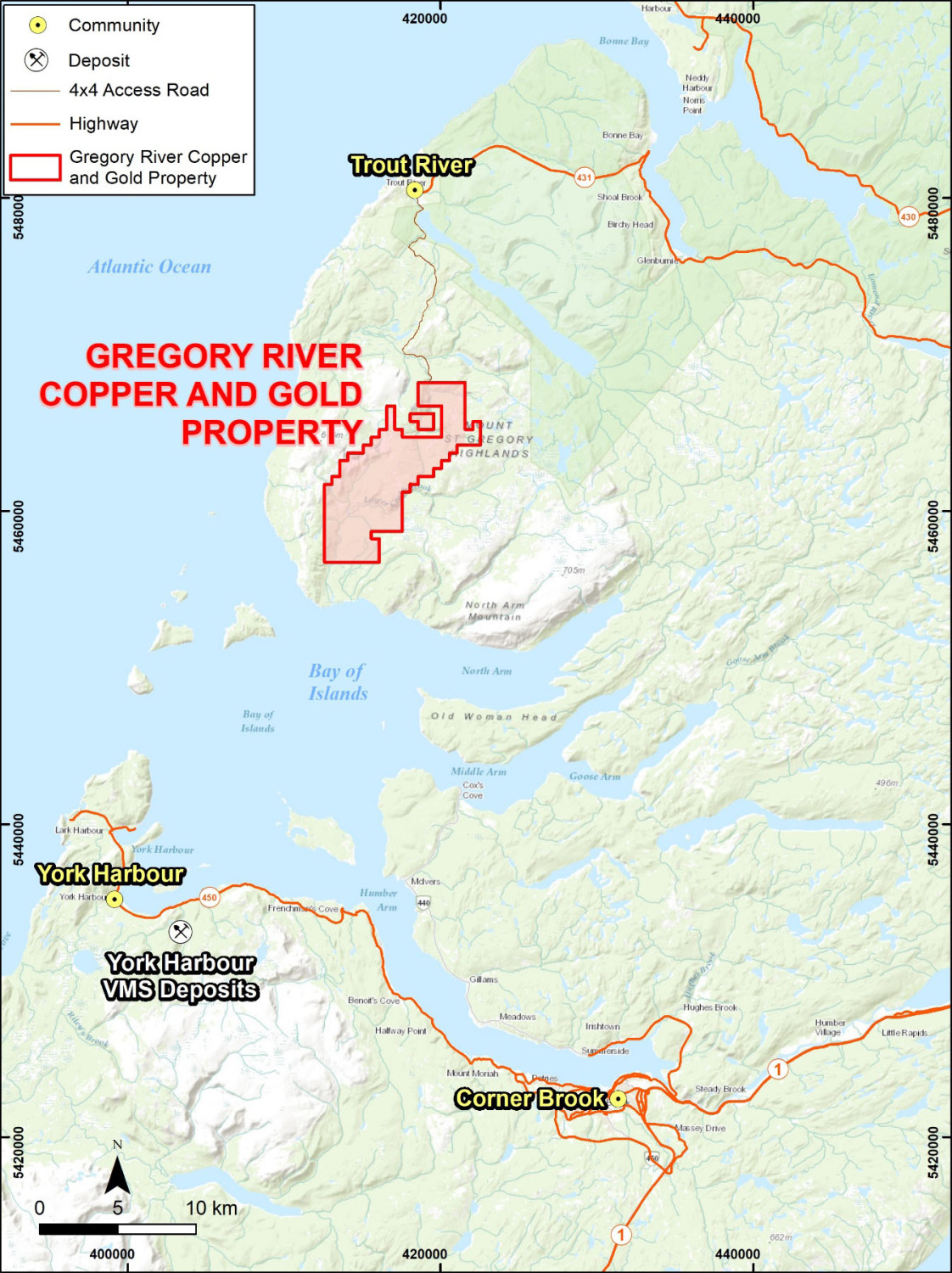
The Property lies approximately 27 kilometres north-northeast of the York Harbour deposit, a Cyprus-type, copper-zinc-silver VMS deposit, which was historically in small-scale production during the early part of the 1900’s and is currently being explored by York Harbour Metals. The Gregory River Property occurs along the same trend of prospective VMS-style mineralization as the York Harbour deposit and is hosted in the northern continuation of the same Bay of Islands ophiolitic sequence of basaltic, gabbroic, and ultramafic rocks with their fragmental equivalents.
Mineralization hosted on adjacent and/or nearby properties is not necessarily indicative of mineralization hosted on the Company’s Property.
GEOLOGY & MINERALIZATION
The Gregory River Property is located on the western margin of Newfoundland hosted within the Bay of Islands Ophiolite Complex, within the Humber Arm Allochthon of the Humber Laurentia Zone. The property is centered over an approximately 11-kilometer-long stretch of the Gregory River volcanogenic massive sulphide (VMS) belt, a north-northeast trending corridor of very prospective ground for precious and base metal mineralization. In addition, the Property hosts a cluster of high-grade copper-gold vein structures that occur just east of the VMS-belt.
The geology of the property is underlain by a faulted and variably deformed, north-northeast trending sequence of ultramafic to mafic intrusive rocks, including dunites, pyroxenites, gabbros, sheeted diabase dikes, basaltic pillow lavas and narrow zones of sedimentary rocks of the Lower Ordovician Bay of Islands Ophiolite Complex. A broad, regional north-northeast trending, gently plunging synform is interpreted to run through the southern portion of the property, with associated local anticlinal fold pairs, and possibly continuing further north. The north-northeast trending Gregory River Fault transects the western portion of the property along with numerous associated fault splays and localized zones of shearing and brecciation. The Gregory River fault and several cross-cutting structures appear to be spatially associated with many of the VMS and lode-style prospects on the property.
The VMS-style prospects at Gregory River are believed to be Cyprus-type deposits and are mostly hosted within basaltic units close to the contact with gabbro and are generally located to the east of the Gregory River Fault. VMS prospects identified on the Property include Lode 9, Gregory River, Moose Brook/Camp Brook*, and Steep Brook/Deep Brook prospects.
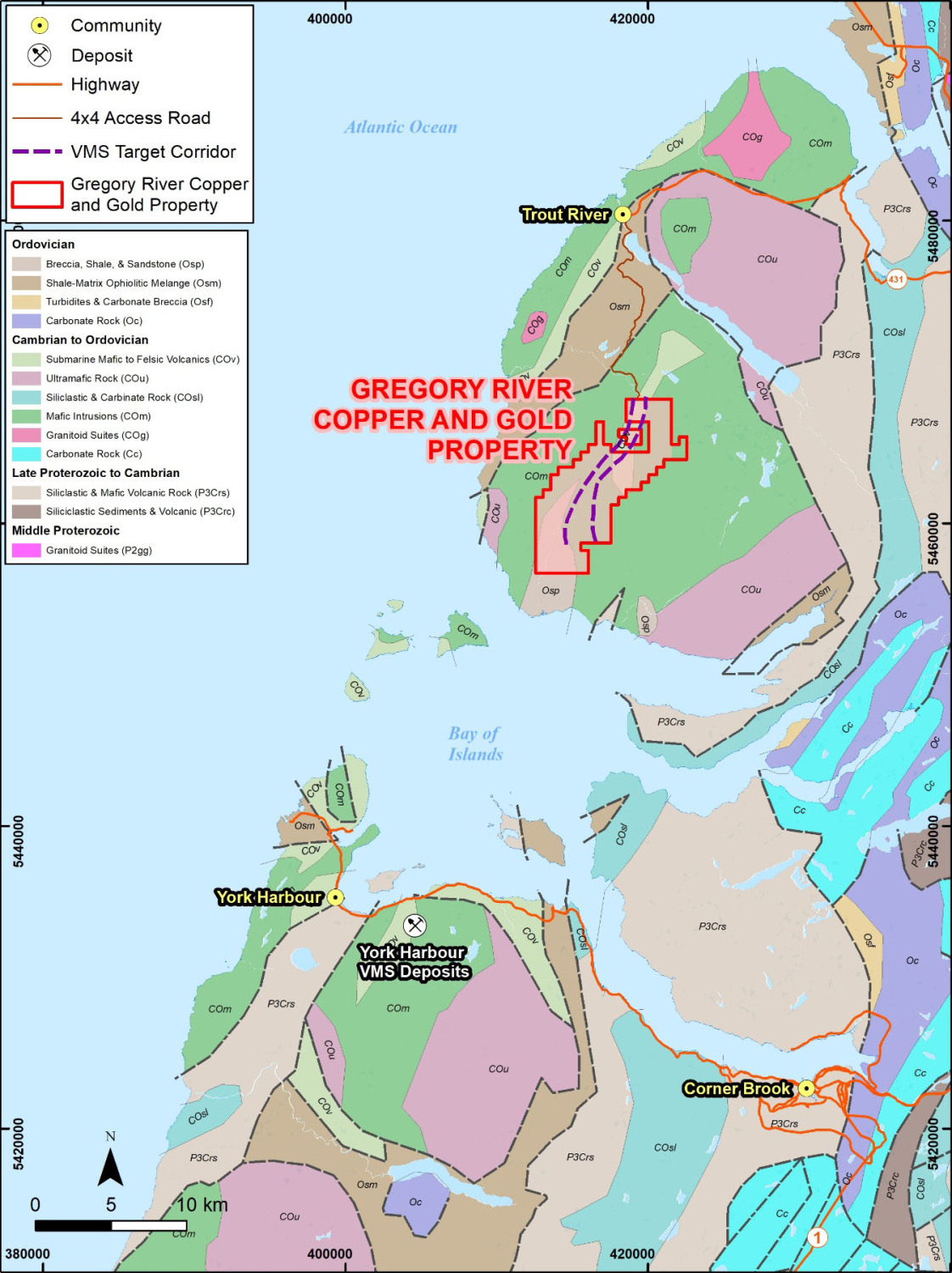
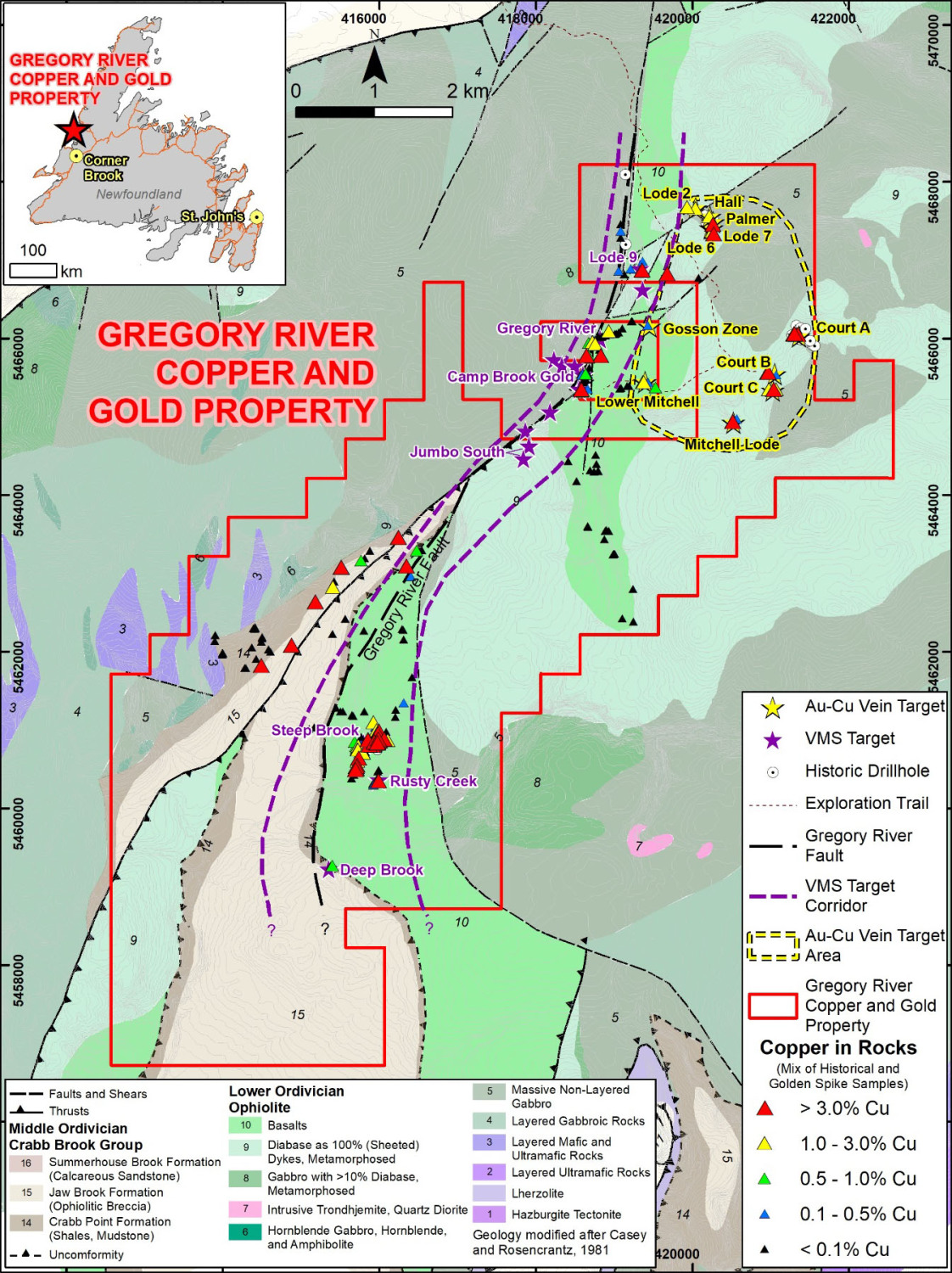
HISTORICAL WORK
Intermittent historical exploration over the property, and within the district, has been carried out by numerous companies since high-grade copper mineralization was first discovered in the early 1920’s. Historical work consisted of prospecting, geological mapping and sampling, stream sediment and soil sampling, airborne and ground geophysical surveys. In the 1950’s two small exploration adits, approximately 30 and 90 metres in length, were excavated at the Mitchell and Palmer prospects, respectively. Subsequent exploration, until the 1970’s, mainly focused on vein-style mineralization and led to the discovery of multiple, high-grade, copper ± gold veins and structures at the Court A, B, & C, Hall, Palmer, Lodes 2, 6, & 7, and Mitchell prospects.
In the northeast quadrant of the property there are several south-easterly to north-easterly-trending high-grade copper mineralized veins and structures which include the Hall, Palmer, Lodes 6 & 7, Court A, B, & C and Mitchell prospects. These sulphide-rich veins are generally 0.5 metres to 2 metres in width, but locally as wide as 5 to 6 meters. Historical surface sampling, diamond drilling and two underground exploration adits have traced these structures for distances ranging from several meters to more than 350 metres along strike, along which copper grades generally average around 2% to 5% but are often in excess of 10% copper. Historically, gold was not consistently assayed, but indications are that anomalous gold grades in the range of 0.1 g/t to 3.0 g/t are locally associated with the copper mineralization, along with anomalous silver, zinc and cobalt. Historical sampling generally focused on the highest-grade portion of the vein and potential exists for wider mineralized haloes to surround the main veins and for the discovery of new veins hidden below the extensive surface soil and till cover.
Starting in the early 1980’s companies continued to evaluate the potential of the veins, but also started focusing more on the potential for stratabound, Cyprus-type, VMS copper-zinc-silver-gold mineralization on the property and in the district, with the most comprehensive programs by Riocanex (Rio Tinto; 1981 to 1982), Duval (1981 to 1985), Noranda (1991 to 1992) and Playfair Mining (2005 to 2008). Their work led to the discovery of several VMS-style mineralized showings and prospects, both on and adjacent to the property.
Since acquiring the Property, Golden Spike has been reviewing and digitizing all of the historical information, dating back to the 1920’s to assist with target delineation and planning for follow-on exploration. This includes downloading and indexing dozens of exploration files from the Newfoundland and Labrador Government’s GeoAtlas, including geological reports, diamond drilling and soils/till sampling logs and assay results, detailed geological maps, geochemical sampling results and geophysical survey data.
The Property has not seen any significant activity since 2008 and still remains largely underexplored.
HISTORICAL DRILLING
Approximately 38 shallow core holes, averaging less than 100 meters in length were drilled to test the vein-style targets at the Court A (17 holes) and Hall/Palmer (11 holes) prospects. In addition, 10 core holes, averaging just over 100 meters in length were drilled to test VMS targets at Camp Brook/Moose Brook (5 holes*), Lode 9 (4 holes) and Steep Brook (2 holes). Three of the VMS targeted holes, one from each target, were abandoned at fairly shallow depths due to drilling problems.
Select significant historical down-hole drill results from Noranda’s 1991 drilling at Lode 9, Duval’s 1984 drilling at Steep Brook, and Playfair Mining’s 2006 drilling at Camp Brook/Steep Brook*, include:
- Lode 9: 0.93% copper and 0.27 g/t gold over 20.2 m (hole 91-2 from 38.0 to 58.2 m)
- Including, 2.12% copper and 0.60 g/t gold over 7.2 m (51.0 to 58.2 m)
- Steep Brook: 0.12% copper over 65.6 m (hole CC-2 from 70.6 to 136.2 m)
- Including, 0.37% copper over 3.4 m (80.0 to 83.4 m)
- Camp Brook/Moose Brook: 0.33% Cu, 0.45% Zn, 0.54 g/t Au over 21 m (Playfair hole GGR-06-04, 5.8 - 28.8 m)
- Including, 0.78% Cu, 1.05% Zn and 1.19 g/t Au over 8.3 m (6.3 - 14.6 m).
*The Camp Brook/Moose Brook prospect straddles the west boundary of one of the licences on the Property and portions of the mineralization may occur on an adjacent property. Insufficient drilling has been done to estimate the true widths of the drilled intervals.
Select historical down-hole drill results* from the 1950’s drilling at the Court A Vein Prospect are shown below:
- 2.13% Cu over 6.1 m (hole 1 from 90.5 to 96.6 m)
- 4.40% Cu over 2.1 m (hole 2 from 87.5 to 89.6 m)
- 4.71% Cu over 1.8 m (hole 5 from 94.2 to 96.0 m)
- 4.65% Cu over 1.5 m (hole 6 from 71.3 to 72.8 m)
- 9.60% Cu over 2.7 m (hole 10 from 76.2 to 78.9 m)
- 4.81% Cu over 1.2 m (hole 13 from 74.4 to 75.6 m)
Documentation of most of the historical drill holes is very limited, especially for the pre-1950’s holes drilled at the vein-type prospects. Historical sampling of much of the drill core from these holes was very selective and only the highest-grade sulphide mineralization was assayed. In many holes only one or two samples were collected per hole, even though drill logs indicate the presence of narrow chalcopyrite stringers adjacent to the main veins in several of the holes. In addition, no assay data exists for some of the holes and very few of the historical drill holes have been kept.
*Gold was not analyzed for these holes. True widths are estimated to be approximately 60% of drilled widths
Since very little of the historical core has been kept, the QP is not able to validate all of the historical drill results. Historical core from hole CC-2 is stored in a government of Newfoundland core shed and representative portions have been re-sampled by the Company returning an approximate similar range of copper grades. Since the companies that collected the historical drilling data were mid-size to large, reputable companies that would have had sampling methodologies and quality control processes in place that were considered industry-standard for that time, the QP feels that it is reasonable to report these results as historical and provide a use guide for future exploration at these prospects.
Airborne Magnetic Survey (March 2022)
In March 2022 Golden Horizon completed an airborne magnetic survey over the Property, as well as target-focused prospecting and sampling. This magnetic survey has been very useful in the on-going interpretation of the mineral potential of the Property and especially the delineation of lithologies, structures/faults and folds and other potentially mineralization hosting structures on the Property.
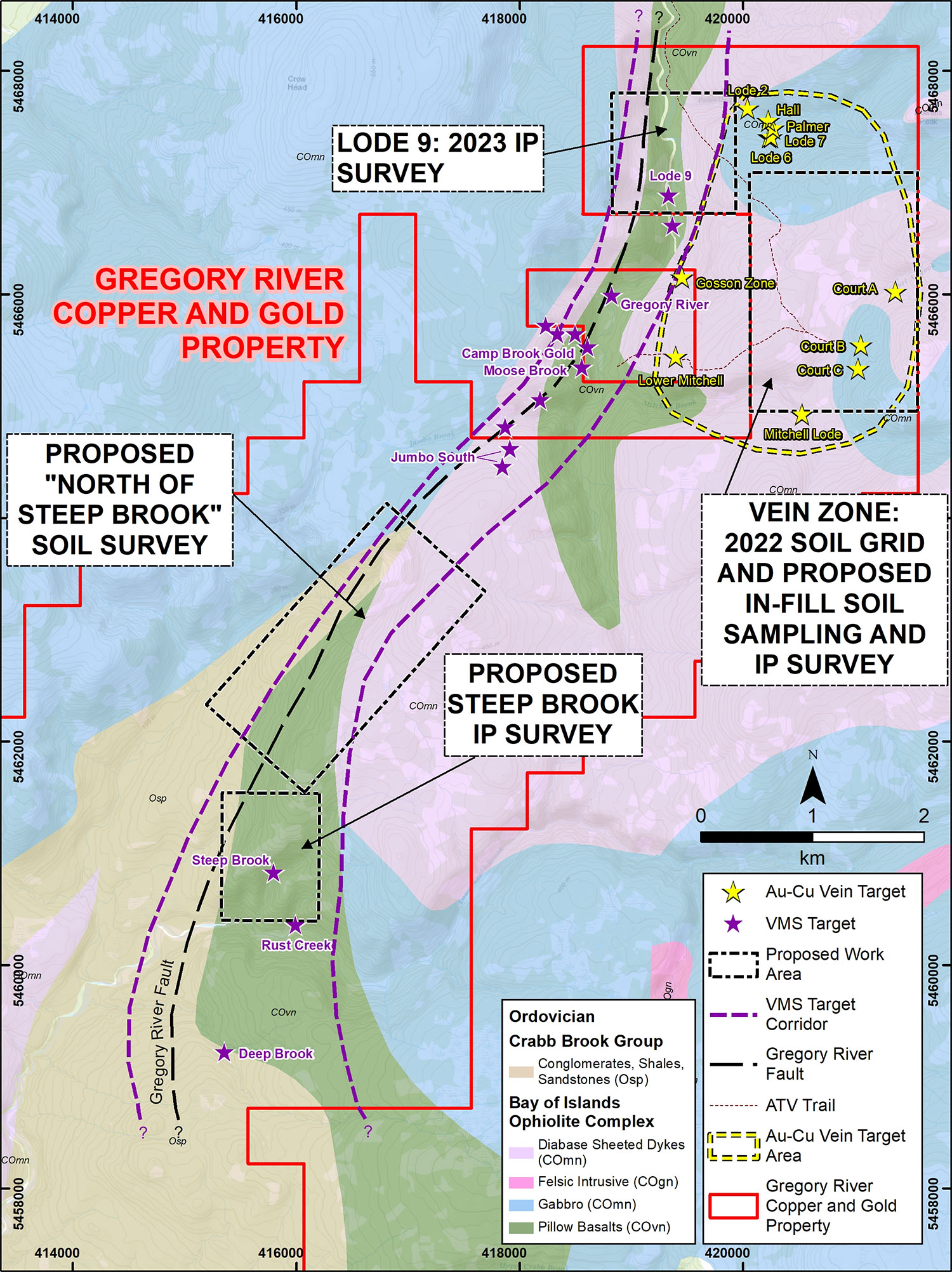
Reconnaissance Sampling Program (August/September 2022)
Shortly after acquiring the Property Golden Spike initiated a prospecting and sampling program at selected target areas in the northern half of the Property (Golden spike Announces Reconnaissance Sampling Results).
Program highlights include:
- 43 reconnaissance rock samples were collected from three volcanogenic massive sulphide (“VMS”) targets (Gregory River, Lode 9 and Moose Brook) and several vein-style targets (Court B, Court C, East of Lode 9, Hall, Palmer, Lode 2, Lode 6-7, Gossan Zone, Lower Mitchell);
- many samples returned highly anomalous copper and gold values, including:
- 15 samples returned values greater than 1% copper, up to 18.7% copper
- 8 samples returned values greater than 0.50 g/t gold, up to 5.02 g/t gold
- Two channel chip sample lines were collected at the Lower Mitchell vein-style target and returned anomalous values of copper, gold, zinc and silver.
- Chanel #2 at Lower Mitchell returned 2.73% copper, 0.14 g/t gold and 0.34% zinc over 5 metres, including 12.9% copper, 0.23 g/t gold, 11.5 g/t silver and 0.27% zinc over 1 metre
Soil Sampling (November/December 2022)
A program of wide-spaced soil sampling was completed over an approximate 1.6-kilometre by 2.0-kilometre grid at the Vein Zone (Golden Spike Announces Soil Sampling Results and Receipt of Exploration Permits). The survey comprised of 203 soil samples, collected at 200-metre line spacing and 50-metre sample spacing, targeting the B-horizon soil layer. Due to difficult weather conditions and the boggy terrain overlying much of the Vein Zone, several of the proposed soil sample locations were not successfully collected leaving occasional data gaps in the grid. Portions of these gaps were later filled in during a 2024 soil sampling program (see “Prospecting, Rock and Soil Sampling (July-August 2024)” below).
The range of analytical values received for each significant element from the Vein Zone soil survey are as follows:
- Copper: 6 - 1,040 ppm
- Zinc: 20 - 412 ppm
- Gold: <5 - 74 ppb
- Arsenic: 3 - 329 ppm
- Cobalt: 7 - 103 ppm
The soil sampling highlights are as follows:
- Soil results reveal several northwest to southwest-trending, multi-element anomalies with copper ± zinc, gold, cobalt and arsenic values.
- The linear soil anomalies overlap with, or occur adjacent to, the locations of known veins at the Court A, B, and C prospects, but also continue for more than one kilometre along strike over areas with no previous documented exploration.
- The soil survey also reveals additional multi-element anomalies providing compelling exploration targets for new veins.
Induced Polarization/Resistivity Survey (April 2023)
Golden Spike completed an Induced Polarization/Resistivity (“IP”) Survey at the Lode 9 Target during April 2023 (Golden Spike Announces IP Survey Results over the Gregory River Property).
The Lode 9 grid comprised of 11, east-west oriented, 100-metre spaced lines, each ranging between 400m and 950m in length and together totaling approximately 7.75 line-kilometres. The lines were surveyed using a pole-dipole configuration with “A”-spacing (electrode intervals) of 50m and “N” (“depth”) values from 1 to 6. The survey was performed on newly cut and chained grid lines and all electrode stations were subsequently measured with differential GPS positioning for greater accuracy.
The survey was designed to outline potential chargeable and resistive features that could indicate the presence of VMS-style alteration and associated sulphide mineralization, and to identify new drill targets. The survey data was evaluated through inversions and modelling, during the 2024 exploration program, which included IP surveys are Steep Brook and the Vein Zone (see “Induced Polarization/Resistivity Survey (July-August 2024)”, below).
Induced Polarization/Resistivity Survey (July-August 2024)
Golden Spike completed an Induced Polarization/Resistivity (“IP”) Survey at the Steep Brook Target between July 18 and August 4, 2024. (See August 19th, 2024 Release). The Steep Brook grid comprised of 11 line-kilometres of IP surveying by Simcoe Geoscience (“Simcoe”), based out of Stouffville, Ontario. Simcoe employed their “Wireless” Time Domain Distributed IP Technology, which provided information to depths exceeding 300m. The 100 m spaced, east-west oriented IP grid lines were centered over the projected trend of the VMS-corridor and are coincident with a 1,400 m long trend of several historical, anastomosing, >100 ppm copper soil anomalies and multiple historical rock samples that assayed up to 19.6% copper (average 3.3%), 27.4 g/t Au (average 1.06 g/t Au), 11.1 % Zn (average 0.23%), and 20.3 g/t Ag (average 5.2 g/t Ag).
Simcoe also completed three, north-south oriented, 1.5 km long, 200 m spaced IP lines over the central portion of the Vein Zone, providing coverage over several of the vein-style prospects. The Vein Zone comprises a series of high-grade, easterly-trending quartz-carbonate, copper +/-gold veins and fractures in an area with very little outcrop. The IP program was designed to identify an IP signature below the known prospects at the Court A, B and C showings and then to trace that signature along strike over areas covered by soil and till horizons. If successful, there is potential to add additional IP lines in the future to better define the targets in this area.
Simcoe also further processed and interpreted the IP results over Lode 9, which was surveyed in 2023, with the aim to provide drill targets for this area as well. The results of the IP surveys were very positive, identifying multiple, high-priority chargeability and resistivity anomalies at each of the three Targets. The IP results, in conjunction with compiled geological and geochemical data, historical drilling data were used to generate proposed drill hole locations at Steep Brook, Lode 9 and the Vein Zone.
Steep Brook IP
The Steep Brook IP survey revealed a “corridor” of subparallel, variably oriented, anomaly trends that cover the entire 1,000 m length of the IP survey, over a width of approximately 375 m that remains open to the north and south. The two major anomaly trends, AT1 and AT2, can be traced over lengths of 700 m northeast, and 600 m northwest, respectively and along these trends are a total of 15 first priority, IP generated targets. In addition, there are three, shorter anomaly trends, AT3, AT4 and AT5 that have interpreted lengths of 200 to 300 m and contain ten additional first priority targets. Surface projection of the IP anomaly trends coincides with the >100 ppm copper soil anomalies (historically collected by Noranda in 1991) and multiple historical rock samples that assayed up to 19.6% copper (average 3.3%), 27.4 g/t Au (average 1.06 g/t Au), 11.1 % Zn (average 0.23%), and 20.3 g/t Ag (average 5.2 g/t Ag).
According to interpretations by Simcoe, the First Priority IP anomalies are generally of moderate size (≥100m x 100m) and exhibit a moderate-to-strong increase in chargeability response (>6 mV/v), accompanied by a marked decrease in resistivity (<2000 Ohm-meters). These anomalies are at moderate depths and interpreted to be consistent with disseminated to semi-massive sulphide with potential for VMS and Cu-Au vein mineralization.
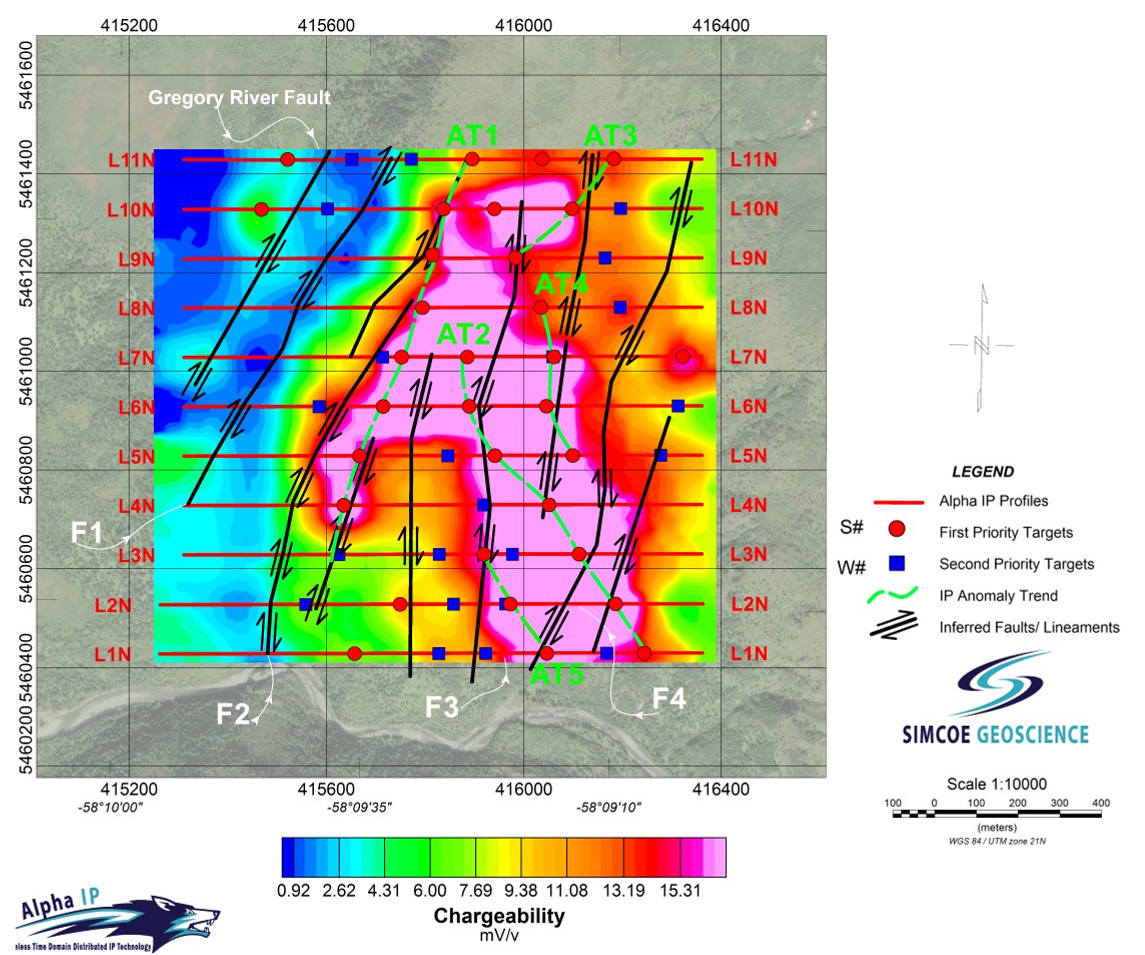 Steep Brook – Plan View of IP Anomaly Trends (Chargeability Depth Slice 100m)
Steep Brook – Plan View of IP Anomaly Trends (Chargeability Depth Slice 100m) 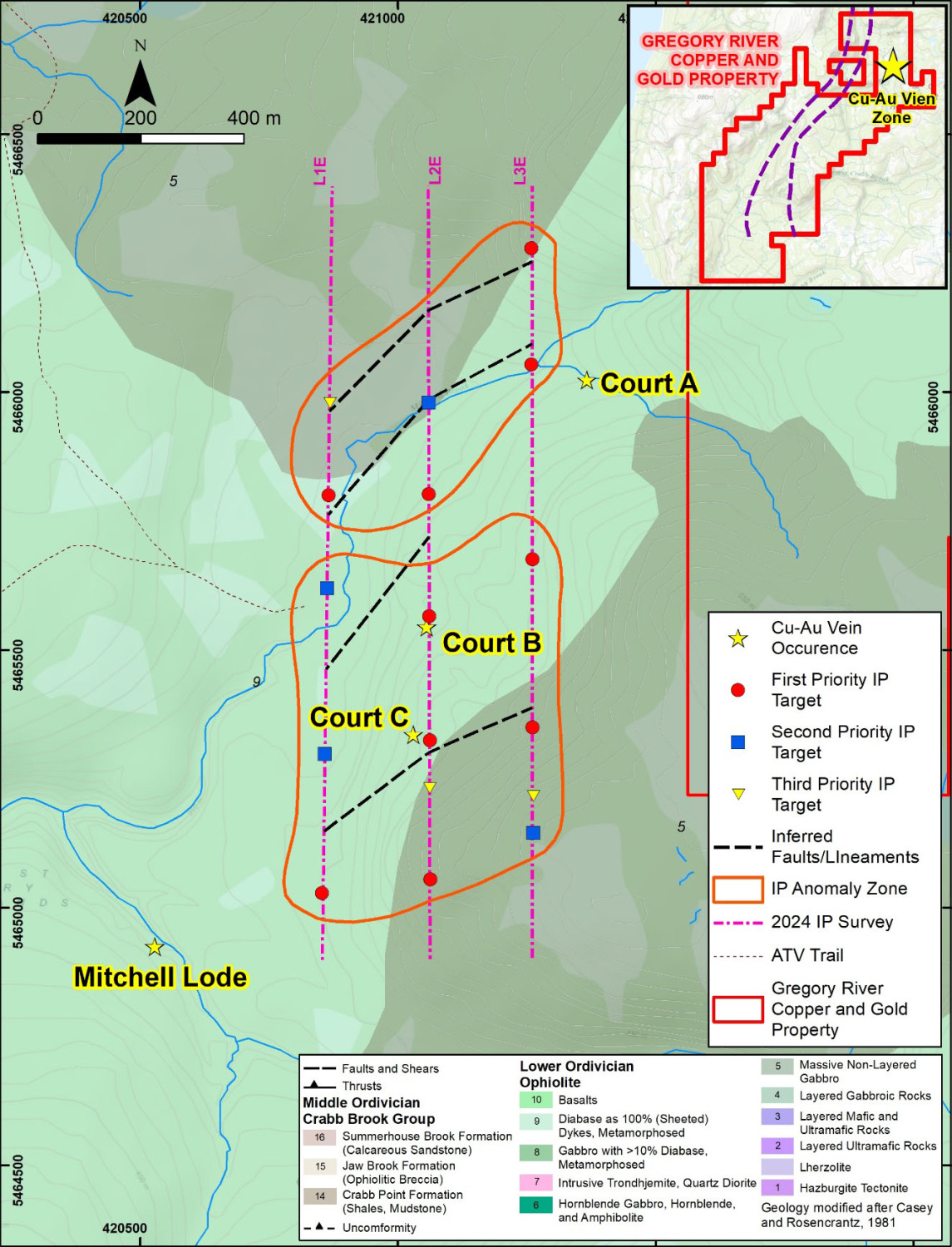 Vein Zone – Plan View of IP Anomalies
Vein Zone – Plan View of IP AnomaliesVein Zone IP
The Vein Zone IP survey results were very positive, revealing 10 first-priority targets, as well as 4 second priority, and 3 third priority targets, grouped into two interpreted “anomaly zones”, AZ-1 and AZ-2. The anomalies are interpreted to be sourced from deep, potentially mineralized intrusive bodies/structures. The shallower chargeability anomalies are the focus of the 2024 drill program and are generally steeply dipping, with strong-to-moderate intensity, and often associated with low-to-moderate resistivity responses.
Many of the chargeability responses are coincident with (located directly below) the main vein prospects and the associated soil anomalies. In addition, the width of the chargeability anomalies appears to be wider than the surface exposure of the vein and some of the chargeability anomalies continue for several hundred metres at depth, suggesting the potential for a wider mineralized system with significant depth extent. The IP survey also uncovered strong chargeability anomalies in areas with no outcrop exposure, possibly representing new veins/structures.
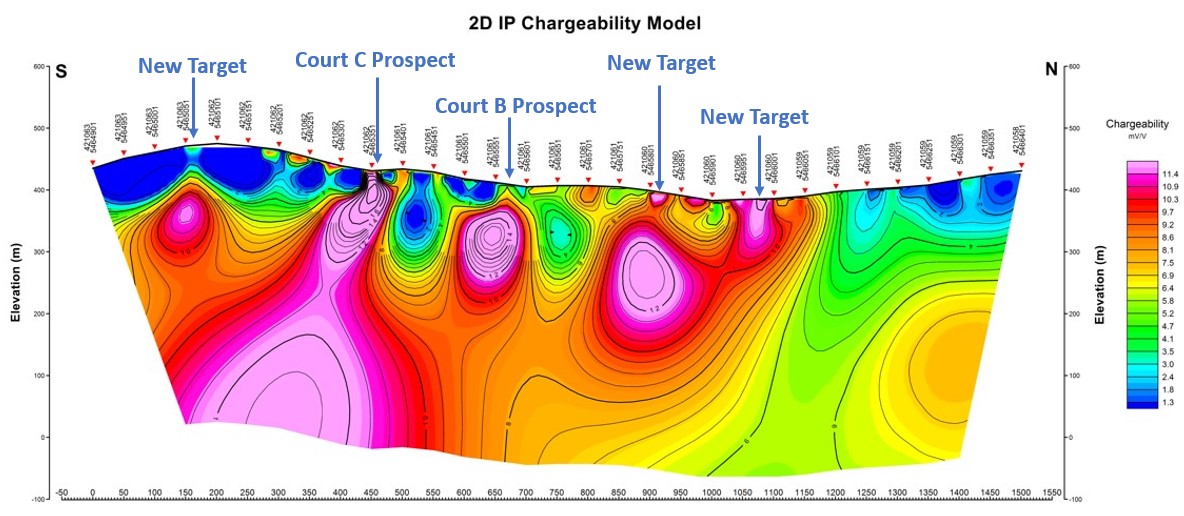 Vein Zone – 2D Chargeability Model Section Line 2E (section looking west)
Vein Zone – 2D Chargeability Model Section Line 2E (section looking west)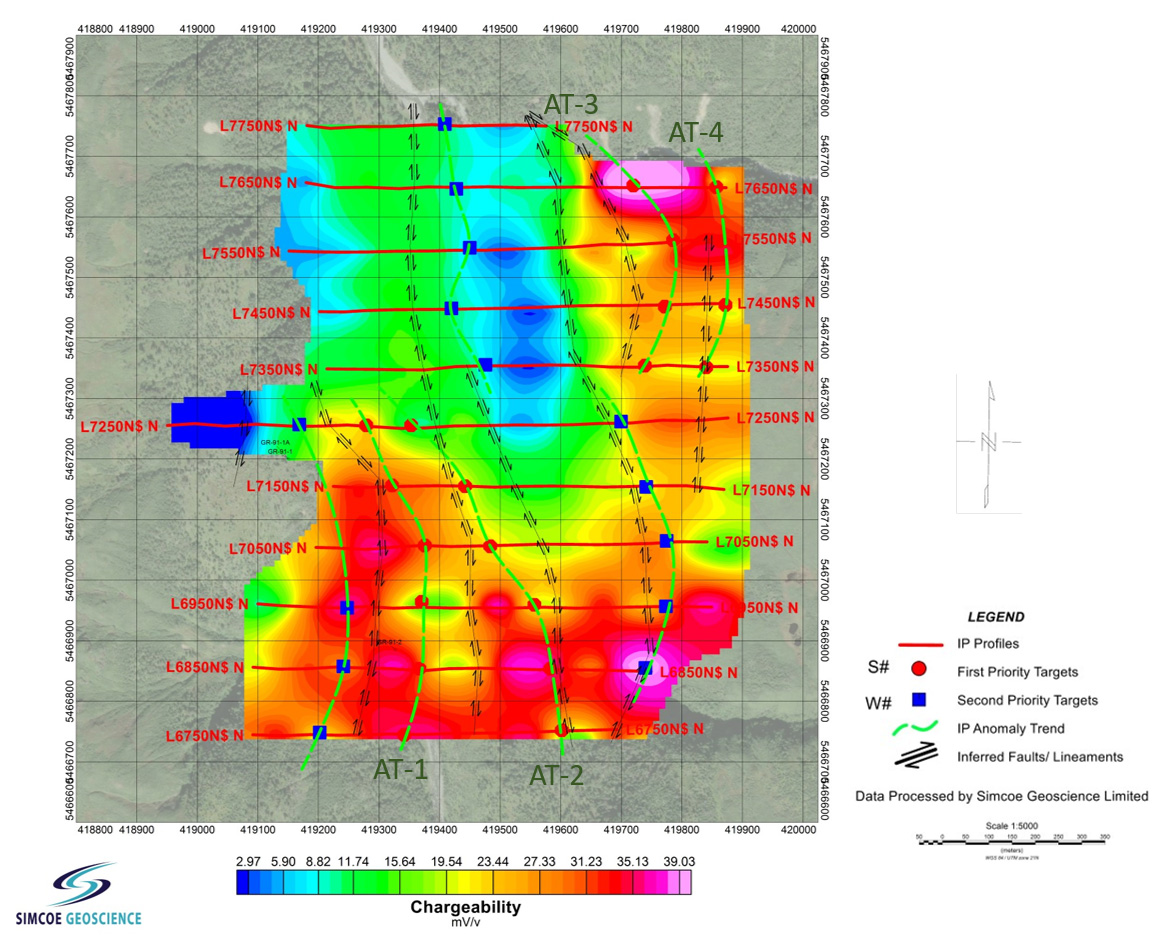 Lode 9 – Plan View of IP Anomaly Trends (Chargeability Depth Slice 100m)
Lode 9 – Plan View of IP Anomaly Trends (Chargeability Depth Slice 100m) Lode 9 IP
The recent inversions and modelling of the 2023 IP data at Lode 9 has revealed two, subparallel, north trending, first priority anomaly trends, AT1 and AT2, both located in the southern half of the grid. Each of these two trends can be traced over lengths of 500 m and along these trends are a total of 12 first priority, IP generated targets. In addition, there are two, shorter first priority anomaly trends, AT3 and AT4 in the northeast part of the grid that have interpreted lengths of 300 m each and contain eight additional first priority targets. Finally, there are three additional second priority anomaly trends that range from 400m to 500 m in length and contain 14 second priority IP anomalies.
IP survey line 6850N cuts across the surface exposure of the Lode 9 prospect and historical drill hole GR91-2. A strong, steeply west-dipping chargeability anomaly corresponds with both of these features suggesting that the chargeability is picking up the VMS-style mineralization at this location.
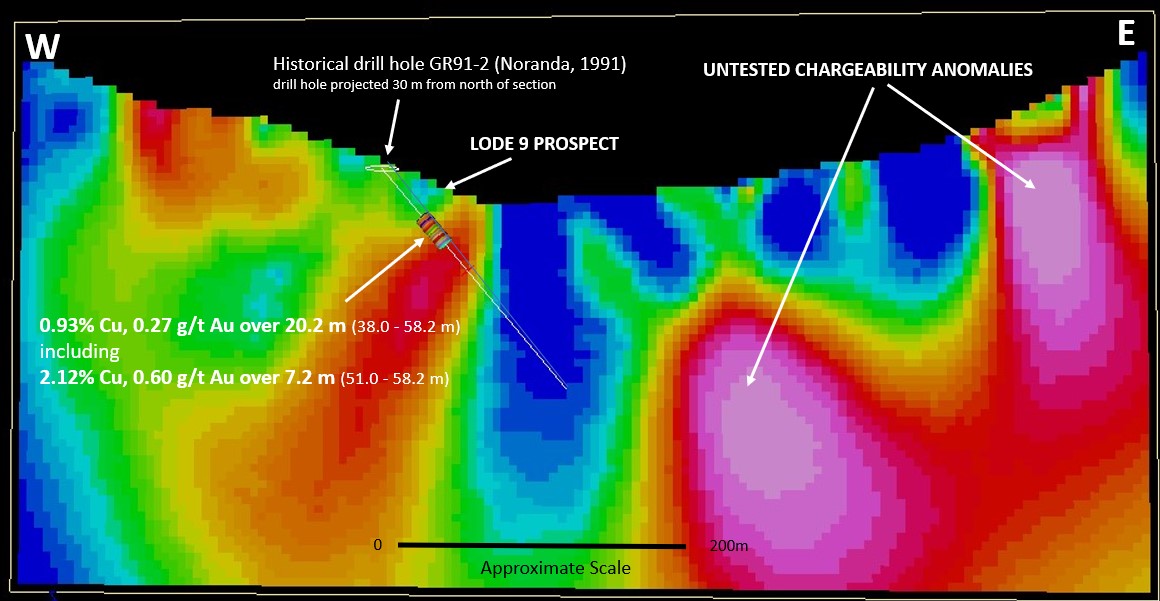 Lode 9 – 2D Chargeability Model Section Line 6850N (section looking north)
Lode 9 – 2D Chargeability Model Section Line 6850N (section looking north)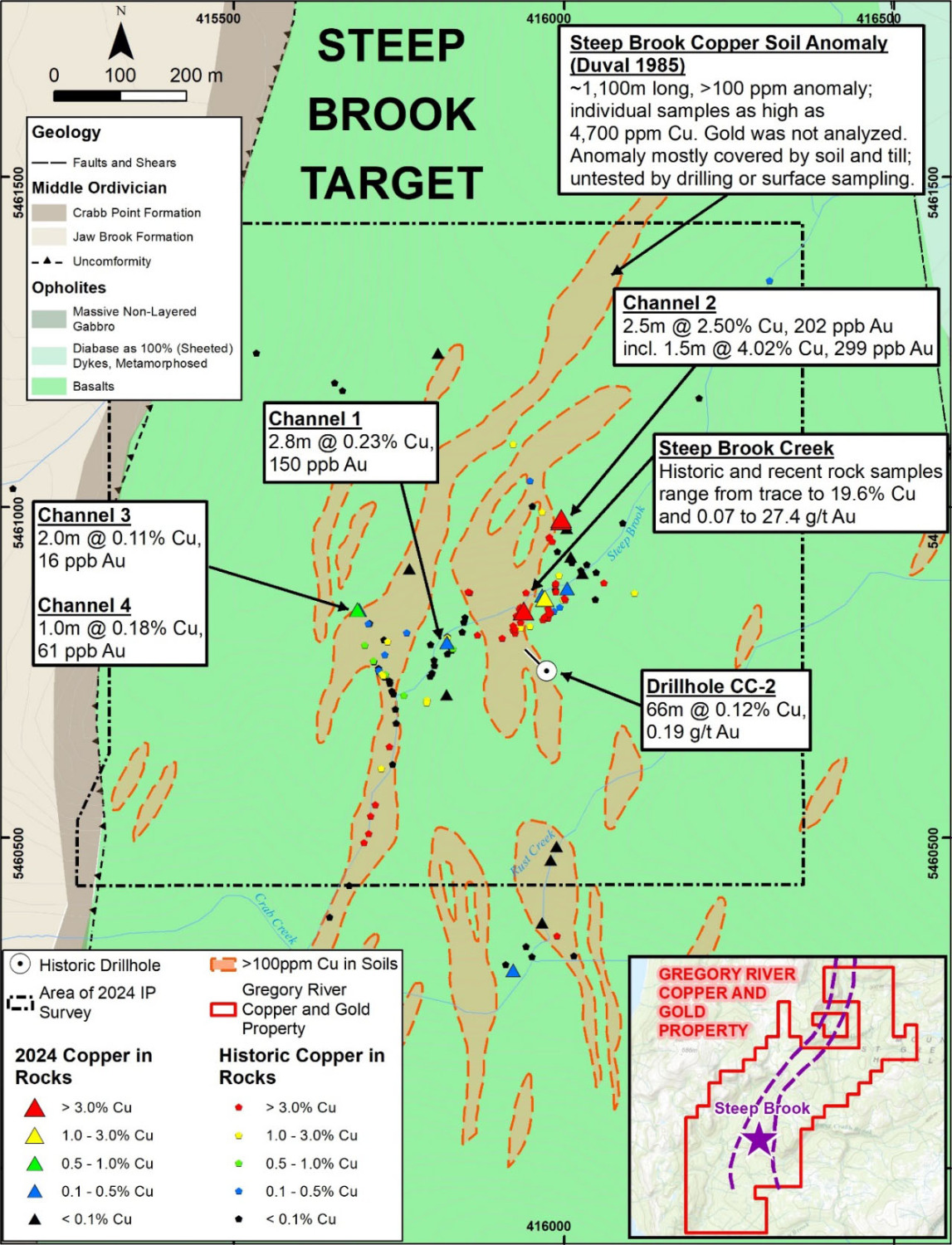 Location of Recent Rock Samples and Historical Sampling from Steep Brook
Location of Recent Rock Samples and Historical Sampling from Steep BrookProspecting, Rock and Soil Sampling (July-August 2024)
Prospecting and Rock Sampling
Company completed a program of prospecting and rock sampling over the Steep Brook VMS target, which was part of the 2024 Phase 1 Exploration Program. Sampling took place between July 19 and 29, 2024. The sampling concentrated in the Steep Brook Creek and some of its tributaries, where the majority of the outcrops occur.
A total of 33 rock samples were collected, which includes 23 mainly grab samples (representative composite of chips) and a few float samples. In addition, 10 samples were collected from four channel sample lines, ranging from 1.0 metre (“m”) to 3.8 m in length. The channel sample lines were saw-cut along the outcrop, creating a sample approximately similar to a drill hole. The various rock samples were collected from both strata-bound and shear-zone hosted mineralization and several returned highly anomalous copper values, along with anomalies of gold, zinc and pathfinder element, arsenic. The highlights of the sampling include:
- 5 grab and channel samples returned values greater than 1% copper, up to 7.57% copper along with anomalous values of gold, up to 0.47 g/t.
- Channel Line #2 returned 2.5% copper, 0.2 g/t gold over 2.5 metres, including 4.02% copper, 0.30 g/t gold over 1.5 metre.
Overall, the rock sample results ranged between:
- trace and 7.57% copper.
- trace and 470 ppb gold.
- trace and 0.72% zinc.
- 2 ppm and >1,000ppm arsenic
Samples are mostly from sheared basaltic rocks, including pillowed to massive flows and agglomerates, with varying amounts of disseminated to semi-massive pyrite, chalcopyrite, and traces of bornite, sphalerite and arsenopyrite. Zones of quartz-sulphide stringers and veinlets are also common. Basaltic rocks are often brecciated and strongly altered to chlorite-carbonate-silica assemblages. Many of the sampled mineralized outcrops, including some of the channel lines, appear to be partially covered by overburden and it is possible that some of the sampled zones are wider, or more continuous along strike than reported. Several of the upcoming drill holes will test these mineralized outcrops at depth and provide a better understanding of the mineralization potential.
The results of the prospecting and sampling program are significant since they support the general range of grades reported from historical sampling programs over the same area and provide “ground truth” evidence of mineralization that corresponds to several of the recently reported IP anomalies and historical soil samples.
Vein Zone Soil Sampling
The recent 2024 Phase 1 Exploration Program also included 35 soil samples that filled in selected data gaps from the original Vein Zone survey in late 2022. As shown on Figure XXX the new samples have successfully extended the copper soil anomalies in the southwest corner of the grid and enhanced the interpretation of the copper anomalies in the vicinity of the Court A prospect.
Combined with the results of the original survey, the interpretation of the copper soil data shows that there are multiple, subparallel, east-northeast trending and anastomosing, anomalies (>90 ppm) that can be traced across the Property for approximately 1,500 m, over widths ranging from 50 to 150 m. Higher grade zones (>150 ppm copper) occur in many of the anomalies with individual copper grades as high as 1,080 ppm. Other significant pathfinder elements, including zinc, gold, arsenic and cobalt, show similar trends.
Many of these anomalies overlap with, or occur adjacent to, the locations of known veins at the Court A, B, and C prospects, but also continue for long distances over soil and till covered areas with no previous documented exploration or mineralization, providing compelling exploration targets for new veins.
Exposures of the vein mineralization are only found at a few locations and mostly occur as one to two-metre-wide, and locally up to five-metre-wide quartz veins and structurally controlled stockwork zones. The northwest to southwest trending veins are hosted predominantly in basalt and gabbro and mineralized with varying amounts of pyrite, chalcopyrite, arsenopyrite and minor bornite and sphalerite. The analytical results from the soil sampling appears to reflect the mineralogy from the veins and therefore provides an effective exploration technique to trace the potential strike extension of the veins below the overburden.
The recent IP survey over the Vein Zone has returned several high-priority IP anomalies that coincide with many of these soil anomalies and several of these will be drill-tested during the current drilling program.
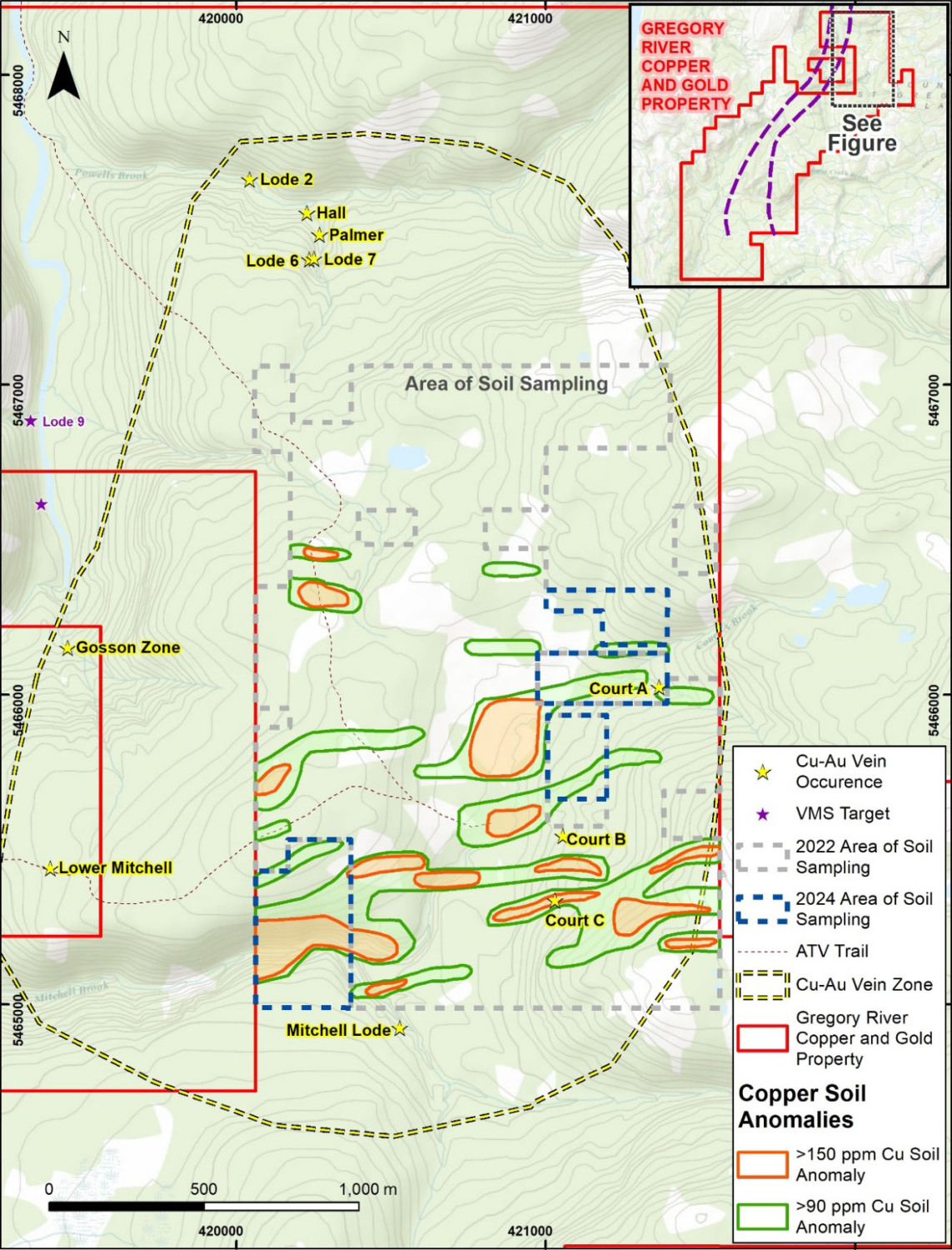
Next Steps
With Gregory River as the Company’s flagship exploration property, Golden Spike intends to continue its systematic exploration for both VMS-style copper-gold-zinc-silver mineralization and high-grade vein-hosted copper-gold mineralization.
- Diamond Drilling: started on October 28th, 2024, and is expected to include approximately 14 holes (3,000 m), split between the Steep Brook, Lode 9 and Vein Zone Targets. The drill holes will test selected First Priority IP targets that have strong support from other layers of exploration data, including geological interpretations, geochemical information, historical drilling, and airborne magnetic data.
- Soil Sampling: North of Steep Brook Target; prime VMS target area that has never been explored.
- Prospecting, Sampling, Mapping: Property-wide prospecting and sampling as well as target focused geological mapping and structural interpretation will continue, developing a base for future targeting.
Project Image Gallery











